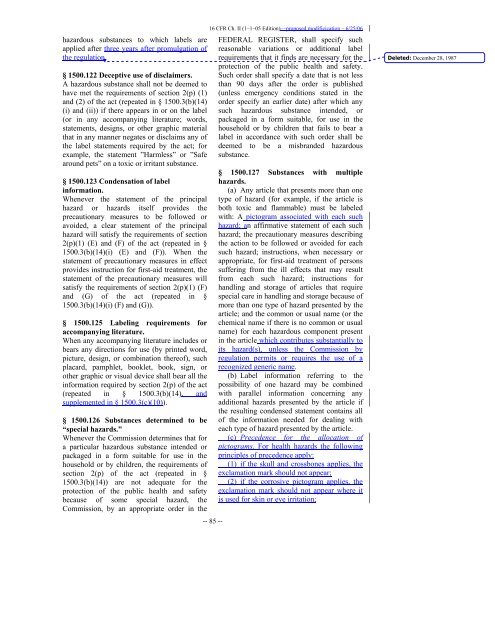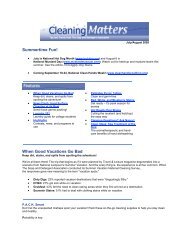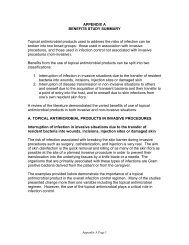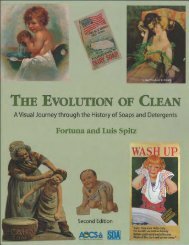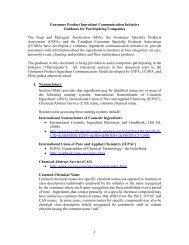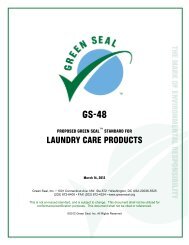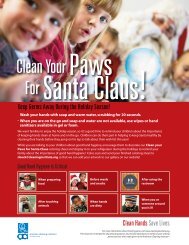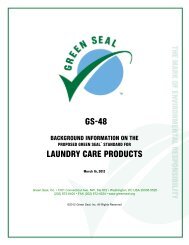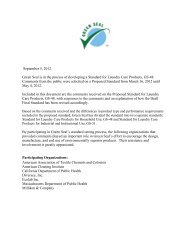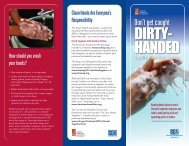subchapter c -- federal hazardous substances act regulations
subchapter c -- federal hazardous substances act regulations
subchapter c -- federal hazardous substances act regulations
You also want an ePaper? Increase the reach of your titles
YUMPU automatically turns print PDFs into web optimized ePapers that Google loves.
<strong>hazardous</strong> <strong>substances</strong> to which labels are<br />
applied after three years after promulgation of<br />
the regulation.<br />
§ 1500.122 Deceptive use of disclaimers.<br />
A <strong>hazardous</strong> substance shall not be deemed to<br />
have met the requirements of section 2(p) (1)<br />
and (2) of the <strong>act</strong> (repeated in § 1500.3(b)(14)<br />
(i) and (ii)) if there appears in or on the label<br />
(or in any accompanying literature; words,<br />
statements, designs, or other graphic material<br />
that in any manner negates or disclaims any of<br />
the label statements required by the <strong>act</strong>; for<br />
example, the statement ”Harmless” or ”Safe<br />
around pets” on a toxic or irritant substance.<br />
§ 1500.123 Condensation of label<br />
information.<br />
Whenever the statement of the principal<br />
hazard or hazards itself provides the<br />
precautionary measures to be followed or<br />
avoided, a clear statement of the principal<br />
hazard will satisfy the requirements of section<br />
2(p)(1) (E) and (F) of the <strong>act</strong> (repeated in §<br />
1500.3(b)(14)(i) (E) and (F)). When the<br />
statement of precautionary measures in effect<br />
provides instruction for first-aid treatment, the<br />
statement of the precautionary measures will<br />
satisfy the requirements of section 2(p)(1) (F)<br />
and (G) of the <strong>act</strong> (repeated in §<br />
1500.3(b)(14)(i) (F) and (G)).<br />
§ 1500.125 Labeling requirements for<br />
accompanying literature.<br />
When any accompanying literature includes or<br />
bears any directions for use (by printed word,<br />
picture, design, or combination thereof), such<br />
placard, pamphlet, booklet, book, sign, or<br />
other graphic or visual device shall bear all the<br />
information required by section 2(p) of the <strong>act</strong><br />
(repeated in § 1500.3(b)(14), and<br />
supplemented in § 1500.3(c)(10)).<br />
§ 1500.126 Substances determined to be<br />
“special hazards.”<br />
Whenever the Commission determines that for<br />
a particular <strong>hazardous</strong> substance intended or<br />
packaged in a form suitable for use in the<br />
household or by children, the requirements of<br />
section 2(p) of the <strong>act</strong> (repeated in §<br />
1500.3(b)(14)) are not adequate for the<br />
protection of the public health and safety<br />
because of some special hazard, the<br />
Commission, by an appropriate order in the<br />
16 CFR Ch. II (1–1–05 Edition)—proposed modificication – 6/25/06<br />
-- 85 --<br />
FEDERAL REGISTER, shall specify such<br />
reasonable variations or additional label<br />
requirements that it finds are necessary for the<br />
protection of the public health and safety.<br />
Such order shall specify a date that is not less<br />
than 90 days after the order is published<br />
(unless emergency conditions stated in the<br />
order specify an earlier date) after which any<br />
such <strong>hazardous</strong> substance intended, or<br />
packaged in a form suitable, for use in the<br />
household or by children that fails to bear a<br />
label in accordance with such order shall be<br />
deemed to be a misbranded <strong>hazardous</strong><br />
substance.<br />
§ 1500.127 Substances with multiple<br />
hazards.<br />
(a) Any article that presents more than one<br />
type of hazard (for example, if the article is<br />
both toxic and flammable) must be labeled<br />
with: A pictogram associated with each such<br />
hazard; an affirmative statement of each such<br />
hazard; the precautionary measures describing<br />
the <strong>act</strong>ion to be followed or avoided for each<br />
such hazard; instructions, when necessary or<br />
appropriate, for first-aid treatment of persons<br />
suffering from the ill effects that may result<br />
from each such hazard; instructions for<br />
handling and storage of articles that require<br />
special care in handling and storage because of<br />
more than one type of hazard presented by the<br />
article; and the common or usual name (or the<br />
chemical name if there is no common or usual<br />
name) for each <strong>hazardous</strong> component present<br />
in the article which contributes substantially to<br />
its hazard(s), unless the Commission by<br />
regulation permits or requires the use of a<br />
recognized generic name.<br />
(b) Label information referring to the<br />
possibility of one hazard may be combined<br />
with parallel information concerning any<br />
additional hazards presented by the article if<br />
the resulting condensed statement contains all<br />
of the information needed for dealing with<br />
each type of hazard presented by the article.<br />
(c) Precedence for the allocation of<br />
pictograms. For health hazards the following<br />
principles of precedence apply:<br />
(1) if the skull and crossbones applies, the<br />
exclamation mark should not appear;<br />
(2) if the corrosive pictogram applies, the<br />
exclamation mark should not appear where it<br />
is used for skin or eye irritation;<br />
Deleted: December 28, 1987


